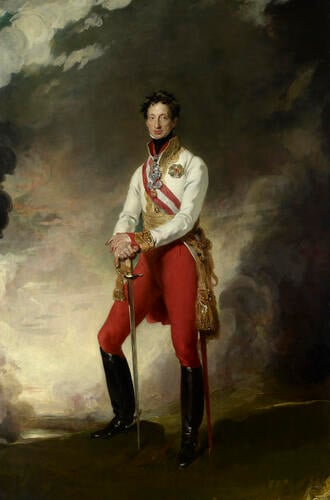-
1 of 253523 objects
Charles, Archduke of Austria (1771-1847) 1819
Oil on canvas | 270.1 x 179.5 x 3.7 cm (support, canvas/panel/stretcher external) | RCIN 405140
-
Lawrence was the most fashionable and also the greatest portraitist of his generation. He was made Principal Painter to George III in 1792 after Reynolds’s death, and received occasional commissions; however it was only after 1814 that George IV began to employ him in earnest. This portrait was commissioned by George IV at a cost of 500 guineas and was painted when the sitter was attending the Congress of Vienna in 1819, though it remained in Lawrence's studio until his death. The portrait seems to have always been intended for what became the 'Waterloo Chamber' and celebrates the sitter’s rank as younger brother of the Emperor and achievement as Commander-in-Chief of the Austrian armies from 1806 to 1809, during which time he was the only allied general who could match Napoleon. Even his final defeat at Wagram in 1809 was a bloodbath for both sides. The Archduke wears military uniform with the Golden Fleece and the ribbon and star of the Order of Maria Theresa. The way in which the hero (in life a short man) is here shown from below as if towering against an inferno of war is a device learned from Reynolds’s military portraits; there is also a striking similarity, which may not be accidental, with Hoppner’s portrait of the only other allied commander who made any impact in the early years of the Napoleonic Wars, Admiral Nelson (RCIN 405901). The Waterloo Chamber is a great hall on the public route at Windsor Castle displaying portraits of those soldiers, sovereigns and diplomats responsible for the overthrow of Napoleon and the re-establishment of the monarchies and states of Europe thereafter. The concept began in 1814 when George IV used the opportunity of the Treaty of London to commission Lawrence to paint distinguished visitors. The group of portraits grew during the next decade as Lawrence continued to obtain portrait sittings at the various congresses following the Battle of Waterloo in 1815 and, in some cases, by making special journeys. Most of the twenty eight portraits were delivered after his death on 7 January 1830. By this time work was already begun of the space of the Waterloo Chamber created by covering a courtyard at Windsor Castle with a huge sky-lit vault; the room was completed during the reign of William IV (1830-7). The first illustration of the interior is provided by Joseph Nash (1809-78) in 1844 (RCIN 919785) and shows the arrangement which survives to this day: full-length portraits of warriors hang high, over the two end balconies and around the walls; at ground level full-length portraits of monarchs alternate with half-lengths of diplomats and statesmen.
Provenance
Painted in Vienna for George IV, when Prince Regent for 500 guineas; added to the inventory of Carlton House dated 1819 (no 648); taken to the Waterloo Chamber at Windsor Castle
-
Medium and techniques
Oil on canvas
Measurements
270.1 x 179.5 x 3.7 cm (support, canvas/panel/stretcher external)
267.0 x 175.4 cm (sight)
